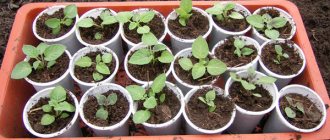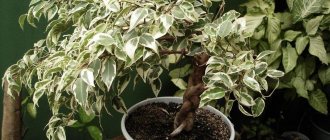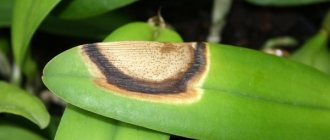Spathiphyllum is a herbaceous perennial of the Araceae family.
Since the 19th century, the flower has been cultivated indoors, attracting attention with a spectacular rosette of green leaves. Dear readers!
For you, we have created communities on social networks in which useful articles and interesting ideas are published several times a day! Subscribe and receive useful content in a convenient format! Several times a year, the plant throws out long arrows of peduncles topped with small inflorescences-cobs. Each is covered with a light bract or spathe, shaped like a leaf. For this similarity, the plant received its name, literally translated from Greek meaning “bedspread” and “leaf”.
Reference! The flower has several popular names. The most common one is “Women’s happiness.” It is believed that spathiphyllum forms buds in anticipation of imminent profit, primarily in the size of the family, which forms the basis of female happiness.
Spathiphyllum is unpretentious. The main measures for caring for it are watering, fertilizing and replanting.
How to determine that a flower needs replanting?
It is impossible to achieve the decorative appearance of spathiphyllum and its regular flowering without replanting, so this procedure is one of the most important components of care. The flower signals the need for it by a change in appearance and vegetation.
- High density of leaf rosettes resulting from the growth of new shoots or children. Over time, some of them begin to wither or dry out due to insufficient nutrition or light. The plant loses its decorative effect and needs to be replanted.
- The thickened rosette falls apart over time. Such a plant looks sloppy and needs replanting in combination with dividing the bush.
- Strong growth of roots, as evidenced by their exit outside the pot through the drain holes and dense weaving of the earthen clod. Overgrown roots need more space (new capacity) and renewal of the substrate, which has used up its nutritional potential.
- Slow growth of shoots and leaves of the plant, as well as a long (more than a year) absence of flowering in spathiphyllum are signals of trouble in the development of the plant, which replanting will help eliminate.
- Spathiphyllum purchased in a store is subject to mandatory replanting.
Spathiphyllum, or female happiness - what kind of flower is it
Spathiphyllum is a tropical flower native to South America. It has no stem, oval leaves grow directly from the soil. The inflorescence is a small white swallowtail on a long thin stalk. This flower is a heat-loving plant, and therefore caring for it is quite difficult. It is necessary to monitor not only the air temperature in the room, but also drafts.
Spathiphyllum
Women's happiness has magical powers: it helps girls meet their chosen one, find a husband and children. However, for all this to come true, you need to communicate with the color and carefully care for it.
How to replant spathiphyllum after purchase?
Transplantation of store-bought spathiphyllum is not carried out immediately, but 2-3 weeks later, after the flower has adapted to new conditions. After making sure that the plant looks healthy, it is moved to a new, slightly larger container with a complete replacement of the soil.
The need for replanting after purchase is caused by the composition and structure of the soil used to grow plants for sale.
- Spathiphyllums are grown on peat soil. The flower grows quickly, consuming all its nutrients and quickly depleting the soil, which will inevitably affect its development.
- Peat soils have a dense structure, preventing air and water from reaching the roots. Once saturated with moisture, peat retains it for a long time, provoking the development of rot on the roots of the plant.
How often should the procedure be performed?
The frequency of transplants is determined by the age of the flower:
- young (up to 3 years) specimens are replanted annually;
- adult forms - once every 3-5 years.
In what pot?
Spathiphyllum grows well in pots made from any materials.
According to this criterion, the choice of container depends only on the personal preferences of the grower or his financial capabilities. The size of the container is selected taking into account the volume of the root system of the flower and its growth characteristics. Since spathiphyllum roots grow more actively in the horizontal direction, the diameter of the pot should exceed its depth.
With each transplant, a container of slightly larger volume (1-2 cm) than the previous one is used. This is important for root development. Only after completely mastering the entire volume provided to the roots does the plant begin to actively grow leaves and bloom.
Reference! Experienced gardeners recommend planting young plants in containers with a diameter of no more than 10 cm. The maximum container size for an adult and large plant should not exceed 18-20 cm.
The pot must have a spacious drainage compartment and drainage holes.
In what soil?
Loose soils with a neutral or slightly acidic environment are suitable for growing flowers.
Soil that meets these requirements can be purchased at a flower shop. You can prepare the earthen mixture yourself. To do this you will need:
- 2 parts of turf land;
- 1 part leaf soil;
- 1 part sand;
- 1 part peat.
- ½ part each of ceramic chips, charcoal and bark.
Ceramic chips, coal and bark are added to give the soil air and water permeability and the required level of acidity.
All components are thoroughly mixed. The soil, regardless of how it is obtained, is disinfected. This will prevent the occurrence of diseases.
Disinfection is carried out in any available way:
- steam for 30 minutes in a water bath;
- Heat for 15-20 minutes in the oven or microwave;
- spilled with a solution of potassium permanganate of medium (pink color) concentration or a solution of phytosporin;
- 2 weeks before planting, to restore beneficial microflora, the soil is moistened by adding EM-1 to the water.
A properly selected and treated soil mixture will ensure good development and, as a result, decorativeness of spathiphyllum.
What pot is needed for spathiphyllum
The rhizome of female happiness is short, with a large number of overgrown roots, which affects the choice of container. Many sources advise that when planting spathiphyllum, take a shallow and wide pot. The root will fit comfortably there, but a thick drainage layer will not fit, preventing stagnation of water, souring of the substrate and rotting of the sucking shoots.
It is better to choose a pot for spathiphyllum of a regular shape; a third will be expanded clay. Wide holes are needed at the bottom to drain excess liquid. The best material is plastic. A clay one will do, but they usually make one hole in the center of the bottom; the water often stagnates.
In order not to spoil the interior, you can choose a designer pot from any material, shape you like, and use it as a flowerpot.
The free space is filled with wet coconut fiber and sphagnum - this increases humidity, improves living conditions, and it will become easier to care for spathiphyllum.
Pot size:
- when transshipment, it should be 2-3 cm larger than before - the crop does not like too spacious, it stops growing until it entwines the ball with roots;
- if a transplant is carried out, the substrate is removed, you can take the same container - the spathiphyllum will push out the flower arrows faster;
- when rejuvenating an old plant, part of the rhizome is thrown away, even if all the rosettes are planted in one pot, in order to immediately get a lush bush, the diameter of the new container should be the same or smaller than the previous one;
- when the owners are going to divide the spathiphyllum, it is recommended to plant the shoots in small pots.
Step-by-step instruction
Spathiphyllum is transplanted using the transshipment method.
Reference! Transshipment is a type of transplantation that involves moving the plant into a larger container while preserving the earthen clod.
The procedure involves performing several sequential actions or steps.
Step 1. Spathiphyllum transplantation begins with preparing the plant. For this:
- At least 30 minutes before the procedure, water the flower well. This will make it easier to remove the earthen ball from the container and avoid injury to the roots.
- The roots are examined. All suspicious (rotten, deformed) areas are removed. The sections are sprinkled with crushed charcoal and dried a little.
- All old leaves are removed from the plant. This will make it easier for the flower to take root.
Step 2. Filling the pot:
- Place drainage in a small (2 cm) layer at the bottom of the new container: fine expanded clay, pebbles or brick chips.
- Soil is poured over the drainage, no more than half the pot.
Step 3. Landing:
- Place a ball of earth on top of the soil in the center and fill the voids with the remaining substrate.
- The soil around the plant is slightly compacted.
- The plant is watered abundantly.
Attention! Often, after watering, the soil settles, exposing the root collar. If this happens, the soil needs to be replenished.
If the procedure is carried out correctly, spathiphyllum will quickly grow its root system.
Reproduction of Spathiphyllum by dividing the bush
Spathiphyllum is most often propagated by dividing the bush in early spring, during a planned flower transplant. To do this, remove the plant from the pot, carefully free its powerful creeping underground rhizome from the soil and inspect it. If you see new growth points where young leaves unfold on the sides in several places, then the bush can be divided so that each fragment has its own growth point and a piece of rhizome with two to three leaves.
This may be interesting: Koleria - home care
The mother plant is returned to its place, filling the voids with fresh soil, and new bushes are planted in separate, small, suitable-sized pots for independent cultivation according to all the rules. It is advisable that during transplantation the ambient temperature be within 20 - 21 degrees. The soil mixture must be suitable for Aroids (see above).
Remember that you should not bury the root neck of the flowers. If planting was carried out in moist soil, then it is better not to water the bushes for a couple of days, but only spray them.
If, when dividing the rhizome of Spathiphyllum, the resulting divisions are without roots, then they can be rooted in sand or perlite. Just place the pots with such cuttings in a greenhouse or cover them with a plastic bag to create high humidity and a greenhouse effect. Ventilate them periodically and moisten them if necessary. After rooting, transplant the bushes into separate pots with a suitable substrate. The author of the following video also shared some secrets of success in propagating Spathiphyllum.
How to plant “Women’s Happiness”
Strongly overgrown specimens of spathiphyllum are planted to obtain new plants and in order to rejuvenate the parent form.
The technology for seating is quite simple and has much in common with transplantation. As in the case of transplantation, it begins with preparing the container, substrate and the plant itself.
- A few hours before planting, the flower is watered abundantly or immersed in a container of water until the soil is completely softened.
- The earthen lump is removed from the pot. The roots are freed from the soil, washed and, after a thorough inspection, divided (cut) into parts or divisions. Each part must have at least 5 leaves and independent roots.
- The cuttings are planted in individual containers filled with fresh soil. The process of planting divisions is similar to replanting, but it is performed with a complete replacement of the soil.
Is it possible to renew the soil during the flowering period?
It is not recommended to renew the soil of spathiphyllum during flowering , since during this period it is especially vulnerable. If you disturb it by replanting it during flowering, then with a high probability the plant will begin to wither. And any damage to the roots can lead to the death of the flower.
In emergency situations, if this is the only way to save an exotic flower, it is allowed to renew the soil during flowering. Then, when transplanting, you need to cut off the flowers and buds with a sterile blade or scissors.
Care after transplant
The key to successful rooting is a properly organized place and care for spathiphyllum.
Organization of a mini-greenhouse and placement
Transplanted spathiphyllum needs warm and humid air.
To achieve this, the plant is given a mini-greenhouse in the form of a sealed cap constructed from any transparent, airtight material.
The flower is kept in the shade for a week after transplantation.
Then they are transferred to a brighter place, avoiding direct sunlight on the leaves.
They can cause burns and wilting of leaves.
Very small sprouts need such devices. Larger specimens can often do without a greenhouse.
Ventilation and watering
Caring for the plant after transplantation consists of ventilation and moistening.
Ventilation is carried out daily, removing the protective cap for 5-10 minutes. During the procedure, the above-ground part of the plant is sprayed with a spray bottle.
Watering spathiphyllum is carried out with boiled or well-settled water at room temperature, alternating moistening with plain water and with the addition of Kornevin. The regularity of moistening is determined by the drying of the top (0.5-1 cm) layer of soil.
After abundant watering, the water accumulated in the pan must be drained.
With proper care, the young plant takes root quite quickly (2-2.5 weeks). Evidence of the successful completion of this process is the growth of new leaves. When they appear, the protection is removed and the flower is cared for as an adult plant.
Attention! Full soil moisture after replanting is resumed only with the appearance of new leaves.
Location
Any corner of your home is suitable for growing Spathiphyllum. Only on the south side near the window will it have to be protected from direct sunlight. A flower illuminated by constantly scattered rays of the sun will grow better, bloom more abundantly and more colorfully. On the north side of the house it will be good at any time of the year, provided that the windows face directly onto the street and not onto a loggia or a tall tree in front of the window. Otherwise, it will bloom more modestly here, grow less quickly and is unlikely to reach large sizes, even with artificial lighting.
In winter, it is better to move the flower to a south window, as it needs a lot of light. In the summer, many flowers love to live in the fresh air - on the balcony, in the garden. But not all types of Spathiphyllum. They do not like sudden temperature fluctuations or climate change. It is better not to take such flowers out into the fresh air so that they do not get sick.
This may be interesting: Types and varieties of Crossandra
Possible mistakes
The plant will signal an incorrect transplantation by a change in appearance.
- Yellowing or wilting of leaves are clear signs of lack of moisture. When they appear, the number of sprays is increased to 2-3 times a day and the top layer of soil is lightly irrigated.
- Withering and subsequent drying of the leaves , as well as the delayed adaptation of the plant, indicate a problem in the condition of the roots - their rotting. This occurs due to improperly selected soil or waterlogging of the soil. In this condition, the flower needs emergency help - replanting with a thorough inspection of the roots and a complete replacement of the soil.
- It often happens that the transplanted spathiphyllum looks quite healthy, but does not grow new leaves. The reasons for this are an incorrectly selected (too spacious) pot or lack of light.
Why do you need to replant spathiphyllum in the fall?
An urgent transplant of female happiness, as spathiphyllum is also called, may be needed in the fall for a number of reasons:
- There has been no flowering for a long time, the leaf blades have been crushed and look wilted. These are signs of severe depletion of the soil mixture, when a complete replacement of the soil in the pot is required.
- Brownish-brown aerial roots have crawled onto the surface of the soil and simply no longer fit in the planting container.
- A rosette of leaves has come out of the ground and is practically dangling in the air.
- The flower has grown too much, forming a lot of children. With a high density of plants, not everyone has enough food and the young leaves that have just emerged begin to wither and dry out.
Spathiphyllum may require replanting in the fall
A recently purchased plant needs replanting. But this should be done no earlier than 15–20 days later, so that the plant has time to acclimatize to the new conditions.
Spathiphyllum usually blooms twice a year. As soon as I notice that it has been standing without flowers for several months, I immediately start replanting it. This plant withstands all manipulations even in winter, so I never wait for spring. The only thing is that at this time I try not to seriously injure the root system and do not divide the bushes.
Answers to frequently asked questions
Is it possible to replant a flowering plant?
A flowering plant should not be replanted. It is better to wait until the end of flowering, especially since it is not that long: 2-3 weeks.
However, there are times when a flower needs urgent replanting: the plant is flooded, suffers from an incorrectly selected pot, or is damaged by soil pests. In these and similar cases, delay is equivalent to losing the flower. Then the risk is justified.
How to transplant a blooming spathiphyllum?
It is better to transplant flowering spathiphyllum on a cloudy or rainy day. In conditions of high humidity, the plant will tolerate the procedure more easily.
Before transplanting, all flower stalks, as well as old and newly emerged leaves, are cut off from flowering plants at the base.
Healthy specimens are replanted using the transshipment method, sick ones - with a complete replacement of the soil.
Why did the newly transplanted spathiphyllum drop its leaves?
This reaction is typical for a plant suffering from a lack of moisture. Water and spray the leaves of the flower.
Why do the lower leaves of transplanted spathiphyllum turn yellow?
They probably forgot to remove them before transplanting. It’s hard for the plant and it gets rid of everything unnecessary. If, after the lower ones, the young leaves also turn yellow, then this is evidence of a lack of nutrients.
When is the procedure prohibited?
Replanting is stressful for any flower. Spathiphyllum has periods when any stress can lead to negative consequences for it.
- It is not recommended to replant spathiphyllum during flowering, as during this period it is especially vulnerable. If you disturb it by replanting it during flowering, then with a high probability the plant will begin to wither. And any damage to the roots can lead to the death of the flower.
- After purchasing spathiphyllum in a store, it is not recommended to immediately start renewing the soil (is it important to immediately replant a purchased spathiphyllum, and how to do it correctly, read here). A change of environment already becomes stressful for the flower, and replanting can only worsen the situation. It would be optimal to wait 2-3 weeks until the spathiphyllum gets used to the new lighting conditions and room temperature, and replant.
- You cannot replant an exotic flower if the room temperature is low (below 15 degrees), as there is a risk of freezing the roots.
Thus, the ideal time to transplant spathiphyllum is the beginning of its awakening after a period of dormancy, March and April. If you replant it in time, the plant will delight its owner with long and abundant flowering.
If you find an error, please select a piece of text and press Ctrl+Enter.











